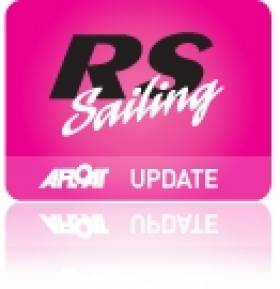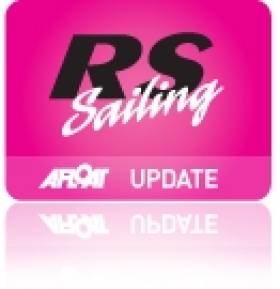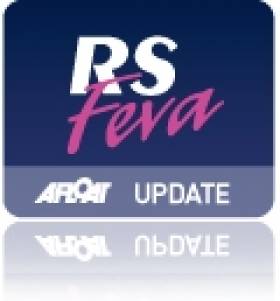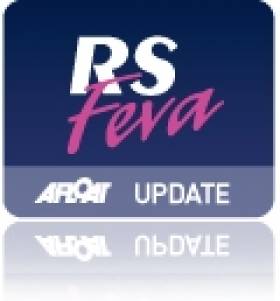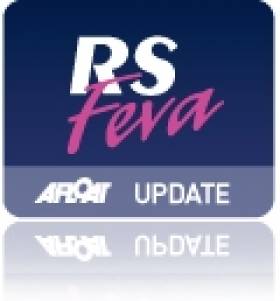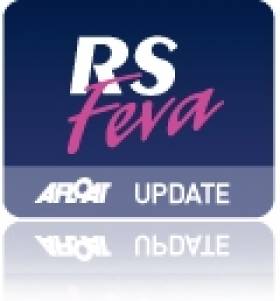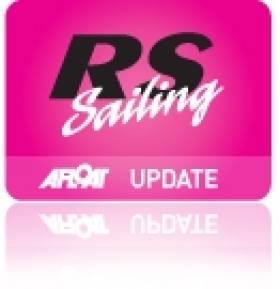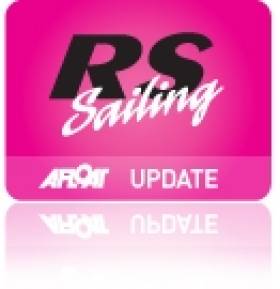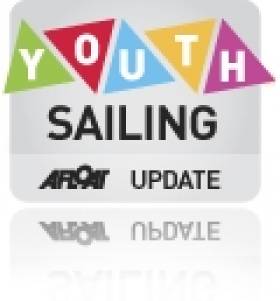Displaying items by tag: Feva
Irish RS 2014 Event Calendar Announced
#RSsailing – The RS Association has announced its event calendar for 2014. These events include all three RS classes, the Feva, 200 and 400 unless otherwise specified.
Primary RS circuit events:
April 12/13th Greystones S.C. Eastern Championships.
June 21/22nd Strangford Lough S.C. Northern Championships.
July 19/20th Lough Ree Y.C. Western Championships.
August 8-10th Galway Bay S.C. Crewsaver Irish National Championships.
September 13/14th Kinsale Y.C. Southern Championships.
Sprint events:
May 24/25th Ballyholme Y.C. RS200/400 Sprint event.
June 7th Monkstown Bay RSFeva/200/400 Southern Sprint event.
UK/European events:
July 25 – August 1st Carnac, France Feva Worlds
July 27th – August 1st Fraglia vela Riva, Lake Garda, Italy RS 200/400 Eurocup
August 17th – 21st Hayling Island, UK RS200 UK Nationals
August 24 – 28th Mounts Bay, Cornwall UK RS400 UK Nationals.
RS200, RS400 & Feva Fleets Northern Champs at Ballyholme
RS – After five races sailed Robert Espey and Mike Gunning won the RS400 Northern championships hosted by Ballyholme Yacht Club this weekend.
Despite the absence of wind forecast, and despite Charlie Horder not showing up, the weekend turned out to be a roaring success, with ever reliable Robin Gray as PRO slotting the perfect duration races into the various wind slots that existed, giving the three fleets great racing.
It was exciting to see some new faces in the RS Fevas, since McCready Sailboats took over dealership, and have been promoting and lending out boats. All 6 of the boats, in the fleet that normally travels from Dublin or Greystones, were from the North. This must augur well for the future, with several parents present realising they could have actually have been sailing in the 400s instead of acting as shore crew.
In the RS200s, Clive Coffey from Newcastle, was dominant in the generally f2-3 conditions, taking first overall from Greystones regulars Frank O'Rourke in second, and Sarah Byrne in fourth, with East Down's Trevor Fisher splitting them in third.
The main event though was in the RS400s, where a super strong line up including current Irish Olympic 49er sailors, and winners of this year's Weymouth Sail for Gold World Cup Series' Championship, Ryan Seaton and Matty McGovern headlined a strong line up of past National and European Championship winners from a multitude of classes. Racing was tight, with the front 6 or 7 generally working through, but with anyone capable of making a podium slot. Overnight it looked to be all about Bob Espey vs Emmet Ryan, but Sunday saw things get a lot tighter, with Gareth Flannigan and Dave Cheyne staying consistent, and nearly turning things around in race two, when Flannigan's lead was slashed on the final run of race two, in what would prove a decisive moment, allowing the Olympic duo a little breathing space as the 3rd,4th and 5th boats rolled the leading pair on the final approach, Espey grabbing an essential win. Race 4 saw Emmet and brother James struggle and take a discard, so it was advantage Espey/ Gunning again.
Race 5 was held in sparkling Ballyholme sea breeze and sunshine, with Dave Cheyne and Stevie Kane from RNIYC breaking clear of the pack, chasing the Ryan brothers. As the two teams extended, it looked like the goose was cooked for Espey, but a last attack on the right corner gybe allowed the fat old boys from Royal North to roll Ryan, and take the win. This instantly threw the result back to Espey and Gunning, who were suddenly back level on points, but with a pair of bullets, to the Ryans only one now, the title went to Espey in dramatic fashion, and past Irish Champions Emmet and James left to lick their wounds. Awesome racing as ever, with some new faces feeling the heat, as those new in last season starting to move up the leader board after a year of hard racing under their belts.
Lots of new boats arriving by the week, with several more expected in Ballyholme in time for the Autumn Grange Wine Merchants Series at Bangor on Sundays from the 8th September, before the fleets head to Crosshaven on September 21/22nd. The hope is the 4 or 5 potential new 400 owners in Monkstown SC in Cobh will have boat boats in time, to compliment the new arrival of Aidan Macsweeney, and also Dave Doherty who currently have boats in the area.
Full results for all divisions are downloadable below as an attached html file.
NI Girls Gilmore & Fekkes Finish Feva Worlds in 41st
#feva – Ireland's Laura Gilmore and Molly Fekkes have finished 41st overall, a drop of eight places in the closing stages of the regatta, counting a poor result in the penultimate race in a massive 171–boat fleet. There was a splendid final day's racing at the Compagnia della vela Grosseto dell'RS Feva Worlds 2013 with Great Britain sweeping the boards with all three podium positions. Bristow/Hewitt are new World Champions. Italy fourth with former winners Stocchero/Virgenti, while Porro/Dall'Ora take All Girls title.
It was an all-British finale today at the Compagnia della vela Grosseto-hosted RS Feva World Championship 2013 with all three steps of the podium occupied by duos from across the English Channel. The new World Champions after 14 races are young Hanna Bristow and Bobby Hewitt (GBR 4610) of Leigh and Lowton YC who controlled their nearest rivals' every move in a 240° wind blowing at 10 knots. They took home a seventh and a 12th-place finish that saw them end the week with a total score of 34 points.
A good 21 points behind them in second place are their fellow countrymen Wells/Todd (GBR 4332), who take the silver medal on 55 points, just one ahead of Brown/Davies (GBR 4768), on the third step on 56 points. Unfortunately, the Italian former World Champions Stocchero/Virgenti did not make it to the podium and, as a result of a 16th and a 3rd place on this final day's racing, had to content themselves with the wooden medal on a score of 75 points. Brits Grade/Prescott also ended up 5th on 77 points ahead of the Italians Porro/Dall'Ora. The winners of the qualifiers, however, can rejoice in having taken the All Girls prize for female crews while the Family prize went to Will and Matt Taylor.
The standings for the other two fleets were also British-dominated with Vennis-Ozanne/Lewis topping the Silver standings ahead of Italians Tognoni/Quilici and Mulcahy/Lindsay-Brown dominating the Bronze.
RS Feva World Championship – Final Standings Gold - Top 5
Complete standings available from: www.sailwave.com/results/RSFevaWorlds2013.htm
The first score awarded for the qualifiers (cannot be discarded)
1. GBR 4610 - Hannah Bristow / Bobby Hewitt - Leigh and Lowton - 3, 3, 1, 6, 1, 1, (14), 7, 12 - 34 points
2. GBR 4332 - Elliot Wells / Jake Todd - Hayling Island Sailing Club - 2, 2, 2, (23), 3, 5, 7, 20, 14 - 55 pt
3. GBR 4768 - Arthur Brown / Niamh Davies - Royal Burnham YC - 9, 1, (17), 10, 6, 6, 1, 6, 17 - 56 pt
4. ITA 4698 - Leonardo Stocchero / Gianluca Virgenti - CV Toscolano Maderno - 5, 7, 9, 13, (58 BDF), 14, 8, 16, 3 - 75 pt
5. GBR 4924 - Samuel Grade / Katie Prescott - Lymington Town/Hayling Island - 25, 6, 4, 1, (58 BFD), 4, 6, 11, 20 - 77 pt
Full results here
Irish RS Feva Sailors in Gold Fleet Finish
#Feva – On the final day of the RS Feva World Championship 2013, Ireland's Laura Gilmore and Molly Fekkes from Northern Ireland lie 33rd over all in the 171–boat fleet.
The penultimate day of racing at the RS Feva World Championship 2013 at the Compagnia della vela Grosseto was dominated by the British teams. With four races held for each fleet (260° wind, 8 knots rising to 14 in the afternoon), there are now four British teams in the top four positions in the Gold standings which will decide the new World Champions.
The new leaders are Hannah Bristow and Bobby Hewitt (GBR 4610) on 15 points as a result of two wins and a 14th-place finish delivered today. Their performance pushed fellow Brits Wells/Todd (BGR 4332) back to second with 21 points (3,5,7) ahead of fellow countrymen Brown/Davies (GBR 4768) in third on 33 points (6,6,1).
This edged the Italian teams off the podium with Margherita Porro and Francesca Andrea Dall'Ora (Associazione Nautica Sebina) slipping into 4th position (46 points) after taking an 8th, a 10th and a 2nd position today, although they are solidly placed at the top of the women's standings. Behind them in 5th are still more British sailors, Grade/Prescott (46 points) followed for now by the reigning World Champions Leonardo Stocchero and Gianluca Virgenti (CV Toscolano Maderno), on 56 points after a very up-and-down day indeed (BDF,14,8).
The Brits are also dominating the other two fleets with Ozanne/Lewis leading in the Silver and Strauss/Mitchell in the Bronze.
Tomorrow will see the two final Gold races being staged (along with three for the Silver and the Bronze), starting at 11:55. Once the racing on the water is over, the prize-giving ceremony for the Bronze, Silver and Gold winners will take place on the Compagnia della vela Grosseto with the announcement of the new RS Feva World Champion.
RS Feva World Championship – Provisional Gold standings after 6 finals- Top 5
Complete provisional standings* available from: www.sailwave.com/results/RSFevaWorlds2013.htm
The first points figure was awarded after qualifiers (cannot be discarded)
1. GBR 4610 - Hannah Bristow / Bobby Hewitt - Leigh and Lowton - 3, 3, 1, 6, 1, 1, (14) - 15 points
2. GBR 4332 - Elliot Wells / Jake Todd - Hayling Island Sailing Club - 2, 2, 2, (23), 3, 5, 7 - 21 pt
3. GBR 4768 - Arthur Brown / Niamh Davies - Royal Burnham YC - 9, 1, (17), 10, 6, 6, 1 - 33 pt
4. ITA 2592 - Margherita Porro / Francesca Andrea Dall'Ora - A.N. Sebina - 1, 4, 21, (49), 8, 10, 2 - 46 pt
5. GBR 4924 - Samuel Grade / Katie Prescott - Lymington Town/Hayling Island - 25, 6, 4, 1, (58 BFD), 4, 6 - 46 pt
RS Feva Irish Girls Duo In Top Third at Italian Worlds
#rsfeva – Three races held in winds of up to 13 knots at the first day's competition at the RS Feva World Championship 2013 hosted by the Compagnia della vela Grosseto leave Ireland's Laura Gilmore and Molly Fekkes in 50th place in a fleet of 171.
English duo Elliot Wells and Jake Todd currently top the standings ahead of Italians Margherita Porro and Francesca Andrea Dall'Ora.
A great day's racing with 12 to 13 knots of 250-270 degree winds greeted participants on day one of the RS Feva World Championships 2013 which now run until Friday, July 26th at the Compagnia della vela Grosseto. After a wait of around an hour and a half to allow the Marina di Grosseto's usual thermals to establish on the course, the committee gave the off at 13:30 to three races for the three categories (yellow, blue and red) into which the 171-strong fleet is divided.
The first team to emerge as overall standings leader is the British duo Elliot Wells and Jake Todd (GBR 4332) who finished the day on just 5 points thanks to one win and two seconds. In second position are the Italians Margherita Porro and Francesca Andrea Dall'Ora (ITA 2592 - Associazione Nautica Sebina), who delivered a second, a win and a fourth (7 points).
The bottom step on the podium went to another British boat, GBR 1883, fielded by Harvey Martin and William Ward. They clocked up a first, a second and a fifth position giving them a total of 8 points. All in all, the Brits dominated the first day's racing with 14 teams in the first 20 positions in the standings. Of the Italians, Pietro Frazzica and Michele Oppizzi (AVAl - CDV Centro Vela Alto Lario) delivered an excellent seventh position.
Tomorrow, the committee is hoping to run three further qualifiers which will bring the event to its final phase during which the fleet will be divided into Gold and Silver groups. The first start is scheduled for 12:00 on the course just off the Compagnia della vela Grosseto.
Irish Girls Take on the World at RS Feva Champs in Tuscany
#rsfevaworlds – There is only one Irish entry in a fleet of 173 RS Fevas but the strong Northern Ireland girls pairing of Laura Gilmore and Molly Fekkes from Strangford Lough YC will be formidable opposition for reigning World Champions, Leonardo Stocchero & Gianluca Virgenti, looking to defend their title on home waters.
346 sailors, numerous parents and supporters from across Europe, North America and Russia are set to descend on Marina di Grosseto, in Tuscany, Italy later this week for the Allen sponsored RS Feva World Championships.
The venue is well prepared for this event having hosted the F18 World Championships last week in superb racing conditions. Again there was a single Irish entry at the F18s as Afloat reported yesterday.
Laura Gilmore is a talented Topper sailor, featuring strongly on previous British and Irish circuits, most notably leading the 2011 British Champs for some of the series.
RS Feva Championship racing will begin on Monday 22 July and conclude on Friday 26 July for the RS Feva, an ISAF Class. The reigning World Champions, Leonardo Stocchero & Gianluca Virgenti, will be looking to defend their title on home waters, whilst challenging them will be the ever-improving sailors from Holland and the GBR RYA Junior Squad sailors. The Czechs are in their first full season of RS Feva sailing and are bringing the largest percentage of their home fleet, showing real determination to impact on the overall results. No team has yet successfully defended the Feva World's title, so Stocchero & Virgenti are looking to be the first.
The race format is set to be in three fleets for the first two days before being split into the Gold, Silver and Bronze fleet for the remainder of the championship. With a sea breeze averaging 12 knots each afternoon, competition is set to be intense.
Tuscany, situated on the Maremma coast is a unique and fascinating location for sailors and parents alike. While the racing is underway parents, siblings and spectators have the option of the beach, a kitesurf school and cycle paths along with an extensive array of restaurants over looking the water.
Follow the action, the defending sailor's progress and the challenger's attack via daily updates on the RS Feva Class Worlds website at http://rsfevaworlds.org/ and twitter #rsfevaworlds. Full RS manufacturer's support will be available to assist with the smooth running of the event.
#rs – Greytones sailors occupy the top three places of the RS200 national championships fleet after three races sailed in Howth today. Roy Van Maanen and Glen Reid lead from clubmates Graeme Noonan and Brian McCarthy. Full results here. In the 24 boat Feva class UK travellers Elliot Wells and Jake Tood from Haylng Island SC are the leaders after three races. There are no results currently posted in the RS400 class also competing in Howth. Scroll down for photos by Gareth Craig.
#RS – UK visitors are among the teams expected to compete in the RS Class National Championships - incorporating the RS Feva, RS200 and RS400 divisions - that will be hosted by Howth Yacht Club from August 17th-19th. A schedule of 10 races for each class is planned by top race officier David Lovegrove and his team.
Entries for the 3-day event from North and South of the border are expected for the RS200 and RS400 championships while the RS Feva event will feature boats from the established fleets in Dun Laoghaire, Greystones, Cork and the host club plus some UK boats travelling over too.
The Feva is a familiar sight in Howth and event chairman Chris Howard says his team are looking forward to also welcoming the 'bigger sisters' in the RS Class for the National Championships which is being supported by a number of sponsors.
Youth Boat Selection Requires Leadership
There has been a call for the Irish Sailing Association (ISA) to take a lead in the big decisions that face youth sailors on what classes to sail to after they leave the ranks of the Optimist, Topper and Feva classes. The call comes from a leading junior organiser who does not wish to be named.
Although youth sailing is buoyant in Ireland it is known there is a 'high attrition rate' among teenagers. The lack of transfer in to senior dinghy classes has been a cause of concern for many clubs around the country.
The comments follow a recently published article on Afloat.ie promoting the RS 200 dinghy as a progression boat for juniors.
"We need a class that will keep youths engaged. The 420 and 29er are great boats but require higher levels of boathandling, are much more competitive and tend to attract the top sailors"
"While the ISA's Olympic ambitions are great to see, it will fail the sport as a whole if it does not tackle this gaping need, the organiser says.
Read the RS 200 article by Ciara Byrne and the junior organiser's comments here
RS 200: the 'ideal' next step for Irish Youth Sailing?
Questions over the next step for juniors after the RS Feva point to the bigger RS200 writes Feva sailor Ciara Byrne
The RSFeva has become the world's best selling two-person dinghy in recent years with fleets also growing in clubs all over Ireland. It is fast becoming the most popular and widespread choice for teenagers and youth sailors who enjoy competitive, active and exciting sailing.
However many questions were being asked recently at the RSFeva Nationals, held in Crosshaven, Co. Cork, regarding the next step for young, talented sailors who wish to continue racing in large fleets without the difficult transition of transferring from the Feva into a larger, unfamiliar dinghy. This uncertainty has led to many sailors dropping out of sailing altogether, while the remainder have split the fleet into Lasers, the 420/470 or moved on to cruisers.
However these dinghies require a lot of time and effort of getting used to, leaving some sailors frustrated and also, less motivated. To avoid this altogether, there is one simple solution: the RS200.
The RS200 is a spacious, one-design, double-handed, hiking, high-performance dinghy which has developed a huge following at club, circuit and championship level in the UK with a growing fleet in Ireland. A pivoting centreboard and rudder allow easy launch and recovery with a thwart giving the crew a comfortable position for light winds. With the asymmetric spinnaker, similar rigging and a similar design, it can be considered as a larger and faster Feva which makes for an easy changeover and the most logical and simple step up.
The ideal weight for an RS200 is 115-145kg (18-23 stone) which allows people of all ages to sail and race effectively in this dinghy. Ideal for teenagers emerging from the Feva, parents, youths, couples, friends and relatives can also come together which enhances the family and social scene.
Even though the 420 has a larger total sail area, the RS200's asymmetric spinnaker of over eight square metres, with a smoother single line hoist and drop system, similar to the Feva's. makes for a faster boat and requires greater tactical and more exciting downwind sailing. This encourages competitive racing and enhanced racing skills.

An RS200 at full speed off Greystones. Photo: Fiachra Etchingham
A maintenance free hull, made of lightweight polyester GRP ensures a long competitive life and second hand boats can be in very good condition so that older hulls are without the disadvantage experienced in fleets such as the 420. Furthermore, every hull comes from the same manufacturer giving no subtle advantage to any one boat; therefore racing just comes down to the sailors' tactics, boat handling and general knowledge of sailing and racing.
While the RS200 is not an Olympic class, there are large UK and Irish fleets which are active and competitive. Johnathan Lewis, a UK Feva coach and RS200 sailor, strongly encourages Feva graduates to move into the RS200 as it is an easy transition and makes for fun and exciting sailing. RS200 fleets are strong in Irish clubs such as those in Northern Ireland including Ballyholme, Newcastle and Cushendall as well as Greystones Sailing Club in Co. Wicklow.
Greystones Sailing Club boasts probably the largest asymmetric dinghy fleet in Ireland with fifty five asymmetric dinghies, twenty one of those being RSFevas and the majority of the remainder being RS200s. Recognising the RS200 as the natural progression from the Feva, ages range from fifteen to fifty five across the RS200 and RS400 fleets in the Club, with most of these boats competing in national events in Ireland, and some in the UK and further afield.

Rounding a mark in the RS200. Photo: Fiachra Etchingham
As fleets build in Dún Laoghaire and Howth yacht clubs, the RS200 is gradually becoming a popular progression from the Feva, and with the RS400 as a follow on boat for larger crews, young sailors can remain involved and spirited in asymmetric racing. The RS200 satisfies a thirst for speed and pace which generates more exciting, competitive and enjoyable sailing for those emerging from Feva fleet.
A Dublin Sailor (who has asked not to be named) has sent us comments on this story:
As one involved in junior and youth sailing at club level, one of the big decisions that faces youths is where to go after junior classes such as Optimists, Toppers, Fevas. Like any other sport, there is a high attrition rate after the age of 14 / 15, especially among girls which is an even greater shame as they can compete on a par with the guys.We need a class that will keep youths engaged. The 420 & 29er are great boats but require higher levels of boathandling, are much more competitive and tend to attract the top sailors. They also suffer from an inability to match up crews who will stick together - teenagers chop and change all the time and its difficult to race a boat like a 420 / Fireball / 29er wihout a constant crew partnership.
We need a boat/class that:
- Enables swapping around of crews without a major impact on the boathandling / teamwork. A sailor's plans for the weekend / event / season are not scuppered because of crewing issues.
- Does not need a highly competent crew (e.g. ability to trapeze and fly / gybe a kite etc.) so that sailors can sail with their mates who may not necessarily be top-notch sailors but who can acquit themselves well in a slightly less complex boat.
- Has a good mixed social scene which is the most important element of any class, youth or otherwise.
- Does not cost the earth in terms of purchase price, is easy on wear & tear on kit (hence replacement & upgrade costs) or does not go soft and become uncompetitive needing a new hull after three to five years etc
- Has international competition that is closeby (UK, FR, Bel, Ned etc) for those aspiring to a bit more
- Has a motiviated class structure to help grow the class.
The fear is that we are starting out another class that will dilute the current youth class efforts. However I believe that the 420 and 29er will hold their own and continue to attract top sailors with ISAF ambitions.
On the other hand, if we continue to support these we will continue to lose the middle ground (and majority) of young sailors from our sport. Youths are fickle enough and if its too much hassle to deal with all the challenges of getting afloat they just won't bother - sad but true.
The ISA needs to take a lead in this and while its Olympic ambitions are great to see, it will fail the sport as a whole if it does not tackle this gaping need in its portfolio of support.
I believe that the RS200 and R2400 provide the best solution to these challenges. They appear well-built and the manufacturer certainly appears well organised and gets involved.
Looking from outside and without any vested interests (other than the health of junior and youth sailing) the RS's get my vote as a class that can make a radical difference.


























